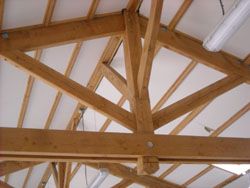Can Any help me with this I am gluing up some Quartersawn white oak tops and for some reason the board are moving swelling and you can see the seams can anyone tell if this is a normal thing or am I doing something wrong it doesn't happen to every seam just a few.
From contributor g6
Sounds to me like wet wood. It doesn't take much.
From contributor Ri
How thick is the white oak? What is the moisture content of the wood? White oak can be tough to dry. Do you mean the seams are opening up, or you can feel them? If they are opening up, how old is the glue and what glue are you using?
From contributor Ga
The top is 1 1/2 thick and the glue was wilsonart #10 PVA, We can't feel the glue seam but there is a swell in the wood on one side of the seam. We saw in the shop the first time we glued it up so we recut and glued it back together and after we installed it. It reared its ugly head again. What I think might be happening is something to do with the wood moisture and because it is quartered if you look at the end on the top to see the end grain this piece the grain is at a 45 degree angle and the other piece is is butting up against the grain is perfectlly vertical so I think the 45 degree is swelling and pushingup or the vertical piece is shrinking down that is the only thing I can think of.
From contributor Le
Glue up the wood, let it dry, rough sand it, let it sit for at least 3 days, final sand it. You shouldn't have problems after that as long as it is the moisture in the glue that is causing this issue.
If you are still having the issue then it's likely that the glue isn't the problem.
Try a different glue and see if you have the same results.
If you keep having this problem try epoxy or urea glue.
From contributor Ri
Really sounds like you have some wet wood. Quarter sawn changes dimension with moisture change in a vertical direction. Letting it sit a little while won't help much if it is changing that much, that quickly. I'd say your supplier ran a bad batch through the kiln. Get a refund, and buy somewhere else. It's likely the whole kiln batch is bad.
From contributor Ge
It sounds like the wood is a bit high in MC, or at least some pieces are. Appreciate that at 45 degrees, you will get about 1% size change with 3% MC change, while with the perfectly vertical grain adjacent piece, it is 6 to 7% MC change for a 1% size change.
Leo G also mentions waiting 3 days while the moisture in the adhesive dissipates before sanding or planing. This is so important, as otherwise the moisture will leave after planing or sanding and you will see a size difference right at the joint.
Note that white oak moves so much with RH changes, it is important to glue within minutes after preparing the surface so that your joints are flat and true.
From contributor Da
I'm reading this post with interest. I am bidding a production run of quartered white oak tables. I haven't seen a recommended MC for receiving the white oak boards. Any more things to watch out for would be appreciated, ie ways to keep MC constant while in production and after. Thanks.
From contributor Ge
First to start, think always about relative humidity. Start with the humidity in the location where the product will be used. Then keep your manufacturing and storage area at that humidity (within 5% RH) if at all possible. Then convert this RH value to an EMC (which is the MC that wood will have at that humidity); for example 37% RH converts to 7.0% EMC, so lumber or wood tables at 37% RH will be at 7.0% MC. Temperature is not a factor.
Because white oak moves a lot with only small RH changes, get the initial lumber MC as close as possible to the in use value.
